

89 questions about Chris “the Greek” Karamesines (or should there be 92?)
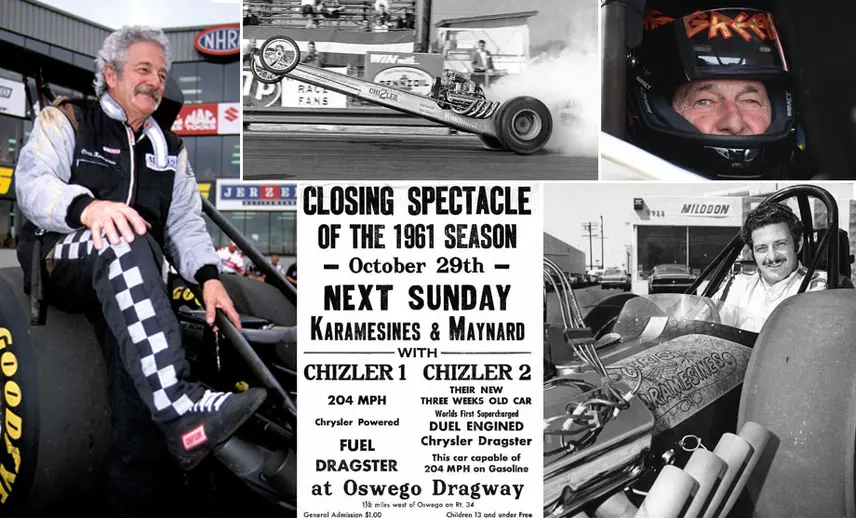
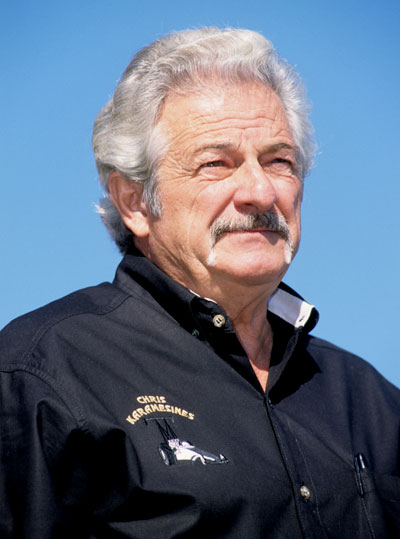
When it comes to the life and times of Chris Karamesines, there will always be some things you can debate. His age. Whether or not he made the first 200-mph quarter-mile pass. How much gold plating really was on his famed Top Fueler. After all, when your drag racing career spans 67 years (61 of them in Top Fuel), there’s a lot of room for discussion.
What no one will ever dispute is what the man we call “the Greek” has meant to our sport. The adjective most commonly associated with him — “legendary — doesn’t even begin to cut it. He’s been there to entertain and inspire us for so long that it seems impossible that he’s really hung up his helmet, ready to turn the cockpit over next year to his granddaughter, Krista Baldwin (daughter of his daughter, Paula, and California Top Fuel racer Bobby Baldwin).
And fans who know him only from the grandstands, watching his timeless driving style over the decades, probably don’t know what a classy guy he is outside the car, too, so I’ve enlisted the help of some people who do know him — maybe you’ve heard of “Big Daddy” Don Garlits and “Kansas John” Wiebe? Jim Head and Lance Larsen? Jack Beckman? Sandy Karamesines?— and to help provide the answers to the questions I posed in my opening paragraph and help close the door (maybe?) on his driving career.
I recently authored a brief history of Karamesines for the final 2020 issue of National Dragster (read it for free here; the story begins on page 62), but four pages were not nearly enough, and since real estate here on the web is basically free, it’s going to allow me to expand on all of that and share more of the comments from his pals and answer your burning questions. All 90-something of them.
Just how old is he?

Karamesines has always been elusive when asked about his age. I think he gets a kick out of it. The records in NHRA’s database say he was born Nov. 11, 1931, and so does his page on Wikipedia, which would make him 89 right now.
In an early 2010 interview in National Dragster, he cagily told our Brad Littlefield that he was “a little over 80” (when meant he would have been 79 with a 1931 birth year). In an interview conducted on Nov. 22, 2014, with Paul Stenquist for Hot Rod, Karamesines’ longtime benefactor, Bob Stange, swore that “the Greek” was 86, which would have meant a 1928 birth year and make him 92 right now.
But, lately, when anyway asks his age, as another reporter recently did, "the Greek" gives the same answer: "Ask Don Garlits.”
Did you?
Of course I did.
"He's definitely 92," Garlits told me with a bit of a chuckle. "For years he said he was the exact same age as Mickey Mouse, so look it up."
I did. Mickey Mouse first appeared in the Disney short Steamboat Willie in 1928. (Garlits, of course, knows this before I begin to Google it while we’re on the phone and admits he had a 16mm copy of the film for ages that he watched incessantly.)
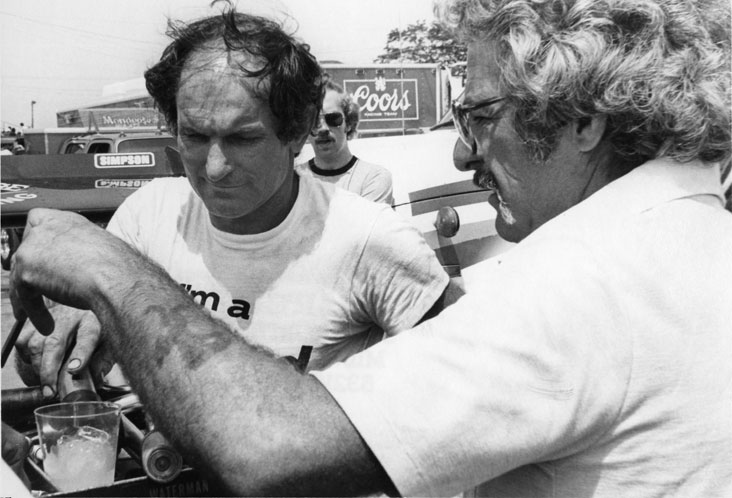
“Decades ago, when we raced against each other, it didn't make any difference how old he was — we all just knew he was a bit older than us (Garlits turns 89 in January) — but it’s a phenomenon is what it is, that he could actually still do it at his age,” said Garlits.
“I wish him a happy birthday every Nov.11. It’s the first call that I make that morning.”
So, then he’s 92, right?
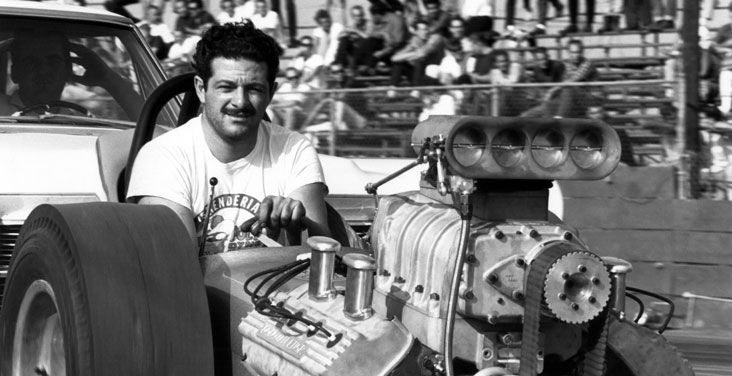
Regardless of what he’s told Garlits over the years, the 1928 birthdate is probably “the Greek” having a little fun with his old pal. According to someone very (very!) close to him (whose name I won’t divulge other than it rhymes with Randy) says she has seen the birth certificate with 1931 on it.
YOU'VE LOST ME ...
As the story goes, 14-year-old Chris was hanging out with the wrong crowd, got into an undisclosed (but apparently not minor) scrape with the law, and was given the choice between spending some time as a guest of the state at the Graybar Hotel or joining the service. With a little inside help, he was able to enlist with a doctored birthdate of 1928, and the number has haunted him since.
Hence the unconventional title to this column?
Truth be told, after talking to Garlits (I was unable to speak to “the Greek” at the time), I was so sure of his age that I originally titled this article “92 questions about Chris Karamesines” and now I’m waffling. Somewhere, “the Greek” is chortling to himself. As “Randy” told me, “I think that he thinks that the less he says, the more intriguing he is.”
The next thing you're going to tell us is that he isn't even Greek?
With a surname like that and a middle name like Socrates, are you kidding me? But records show that he was actually born in Detroit.
Did he really win a Purple Heart?
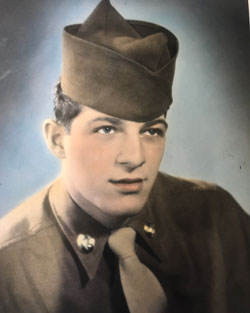
True fact. The story goes that Karamesines was wounded in the leg by a sniper during an attempted escape by a prisoner while “the Greek” was a guard during the 1946 Nuremberg Trials. He didn’t report it at first because he didn’t want to be sent home, and his buddy, a medic, patched him up on the down-low. He later had to leave the service after getting crushed by a heavy truck in a motor pool accident that broke his ribs, and he spent a year recuperating.
Believe it or not, there’s no authoritative and complete list of all Purple Heart winners and even though the site PurpleHeart.com does not list him among the 78,197 names in their database, “the Greek” has so many accomplishments to his credit that he doesn’t need to brag about — enough of his friends say they have and brag for him — so I’m going with yes.
When did he first start racing?
After getting out of the Army in 1951 and spending his last few years in service in the motor pool, it’s not a surprise that when he returned stateside that he got into racing.
“I’ve always been interested in speed,” he admitted. “Motor scooters, motorcycles, race cars. I was interested in all of them.”
By various accounts, he started racing oval-track modified stockers in anywhere from 1949-51, racing all over Chicago at places like Bedwell Stadium, Raceway Park, and the 87th Street Speedway on the mean streets of Chicago’s South Side.
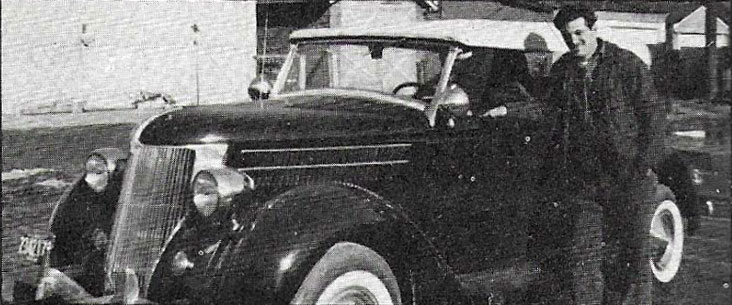
Not that “the Greek” wasn’t into hot rodding, too. He was a member of the Schlitzers car club (named after the famed Milwaukee brand of beer, whose trademark was beer can hanging on the back of their cars). His first car after leaving the Army was a flathead-powered Model A and he also had a ’49 Olds, but his go-to car quickly became this ’36 Ford Phaeton four-door convertible with an Olds engine. This is the car in which he made his first trips down a dragstrip.
Where and when did he get into drag racing?
By all accounts, “the Greek” made his first passes down a dragstrip in 1953. on the airport dragstrip in Half Day, Ill. He ran the car in the A/Street Roadster class and set track records of 12.21 and 122 mph on pump gas.
Half Day sounds like a silly name for a city. What’s the story there?
Apparently, back in the day — before even Karamesines’ time — the city was so-named because it was a half-day’s ride by carriage from Chicago.
When did he get his first dragster?
Although I’ve read articles in which he claims it was 1955, most of the interviews and data seem to indicate in 1956. He bought a bunch of junkyard tubing and just built one with an 88-inch wheelbase. (Although some reports I’ve read said that the car was built using rails from Scotty Fenn’s popular Chassis Research TE-440 kit, I think that was from the rollcage that he later added.)
“I wanted to be able to go faster,” he explained simply. “I wanted to advance to an all-out class. I’d see pictures of people in rails and stuff that’s all chopped up, and I did the same thing.”

He took the Olds engine from the Phaeton, which by that time had run 124 with a 5/8 stroker crank and put it in the dragster and, according to the man himself, debuted the car in Aurora, Ill., in early 1956 with a carbureted setup.
And then he met Don Maynard?
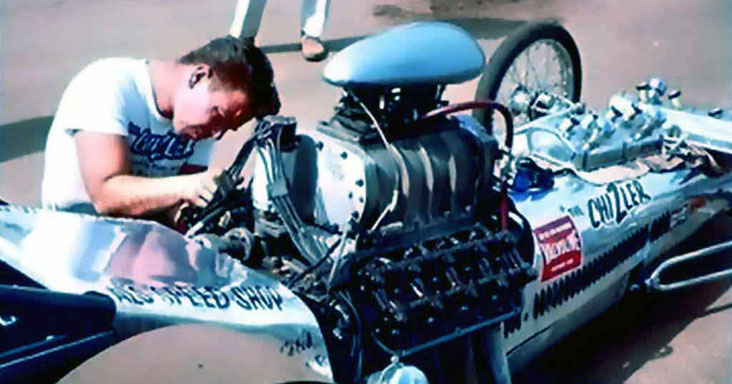
That didn’t happen for about another year. Maynard was already a respected wrench and part owner with Lyle Fisher of the already-famed Speed Sport Roadster out of Arizona. Like Karamesines (and practically every hot rodder back then), he was a member of a car club (the Lords, out of Tucson).
Karamesines, who was already experiencing a fair bit of success that summer by himself, met Maynard met at the ATAA World Series of Drag Racing in Cordova, Ill., the weekend before Labor Day 1957. They hit it off famously and soon formed what would be the toughest Top Fueler in much of the country over the next five-plus years. Maynard was just 24 years old when they first met; Karamesines would have been 31.
What does Karamesines say about Maynard?
“He’s the one who got me started in fuel because I didn’t know anything about it,” he admitted. “I tried to run it but didn’t know what I was doing. He’d come over and give me some pointers, and we decided to go together. He was a smart guy as far as tuning. His life was about making a car run.”
So this is when "the Greek" became a full-time racer?
Pretty much. He quit his job at the City of Chicago Water Dept. and partnered with Maynard on an engine-building business, Engine Specialists, that for a time sold both engines and chassis, though they later focused on engines.

The Olds powerplant was replaced with a carbureted 354 Chrysler in 1958 and they added a blower in 1959 to turn it into a full-fledged Top Fuel car. Karamesines won the biggest event in the sport at the time, the World Series of Drag Racing at Cordova, Ill., and backed that up with the AHRA Top Fuel title in Great Bend, Kan., beating Garlits in the fuel final and gas winner Eddie Hill for overall Top Eliminator honors.
Top Fuel in 1959? I thought Top Fuel staRted in 1963 at the Winternationals?
“A lot of the gas cars had blowers back then,” explained Garlits, “but West Coast guys like Jerry Cagle and Art Chrisman were experimenting with nitro, so there probably were some blown fuel cars in late ‘58 but, again, with just a small amount of fuel, not the large amounts that we ended up running.”
What did Garlits think of “The Greek” when he first met him?
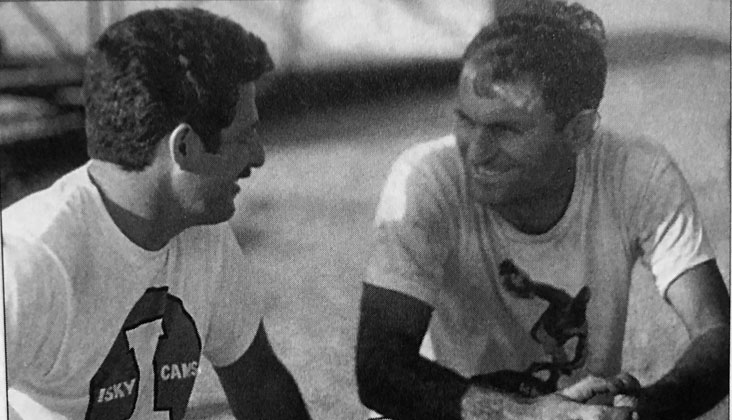
“We had heard there was a guy in Chicago named ‘Chris Kerosene’ and that's all I’d heard. People did that to people’s names back then. I was Don Garlic [and sometimes even Don Garbage] but we both raced at the 1959 AHRA Nationals and he beat us in the final, so I knew he was for real.
“The fans, they loved him. I saw him at Cordova with that short car and the front wheels came up at the eighth-mile and he drove right through the finish line with the wheels in the air. He was fearless.”
And then came “The Chizler?”
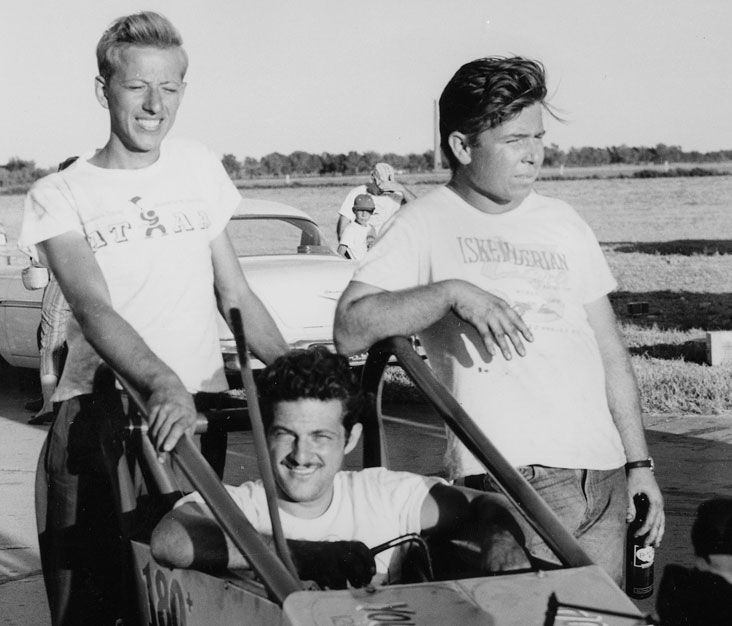
Yes, sir. They built a car with a longer wheelbase — 104 inches but at a flyweight 1,525 pounds — with their third partner, George “the Bushmaster” Schreiber (who was “the Greek's” brother-in-law) but Schreiber soon joined the military. It was called “the Chizler” (because that was the nickname back then for Chrysler engines) and was sponsored by Al’s Speed Shop in Aurora, Ill. That's Schreiber at left with Maynard and "the Greek."
And this is the first car to break 200 mph?
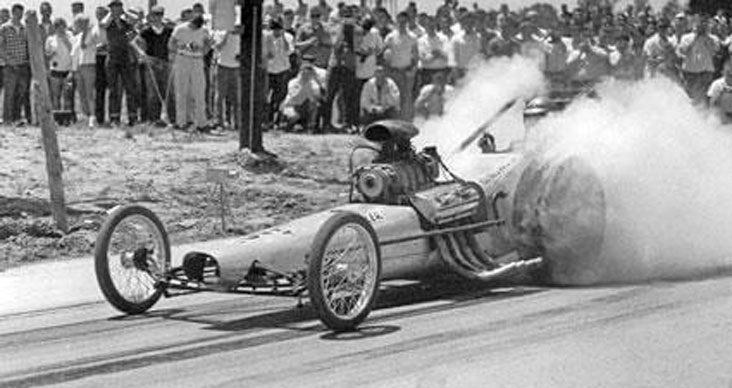
Although Connie Kalitta will beg to differ, yes. Karamesines ran 204.54 in the car at about 2:15 p.m. on April 4, 1960, at Illinois' Alton Dragway.
I thought Don Garlits ran the first 200, no?
While Garlits did get the first NHRA national record at more than 200 mph with his pass of 201.34 at New Jersey’s Island Dragway on Aug. 2, 1964, even “Big Daddy” gives Karamesines the credit for the first 200-mph pass. “I set the first 200-mph NHRA national record but, as far as the first 200 speed, that belongs to ‘the Greek,’ ” he told me.
So, why does this debate rage on?
The single biggest case against “the Greek’s” 200 is that the Alton track was running Fosdick timers.
“Those Fosdick clocks which were known to not be exactly accurate sometimes,” said Garlits, “Most of the timers back East were the Fosdick timers, and you could get accurate times out of them, but you had to be really particular about the voltage that was going to them. Most of the problem was that the clocks were operating on little generators out on airports and so if the generator speeded up or slowed down it changed how fast the clock ran, but we all know now that [200 mph] is not a real hard number to hit, so it’s entirely possible that he did it.”
“It’s entirely possible?” That seems kinda vague, Phil.
Purposefully so. The Sept. 10, 1960 issue of Drag News reported that after all of the handwringing over the Fosdick timers at Alton, track management there was able to borrow the Chrondek clocks from Kansas City Int’l Raceway and was able to run them in parallel with the Fosdicks at the track’s Midwest Drag Classic event. Most — but not all — runs compared identically on both timers but there were some outliers. A run by Art Malone that registered 173.07 mph on the Chrondeks came up as 180.00 on the Fosdicks (+6.93 mph) and where the Chrondeks clocked the Speed Sport roadster at 160.71, the Fosdicks gave it a 163.63 (+2.92 mph).
How did the Fosdicks create the mile-per-hour reading?

Not just the Fosdicks, but some other systems as well. It’s not like today where you get a digital readout of the speed. The timers didn’t automatically come up with a speed number, but rather a separate elapsed time counter that measured the time in milliseconds that it took to traverse the speed traps, and the announcers had to manually compare that secondary elapsed time to a chart that gave the corresponding speed. In Alton, because their conversion charts (and probably everyone else’s) stopped well short of 200 mph, the announcers had to drag out their slide rules (or abacus or whatever) to calculate the speed by hand and came up with 204.54.
Is that 204.54 number exactly accurate? Doubtful. As drag racing's uber historian Dave Wallace (a “Greek 200” skeptic) explained to me, “The faster the speeds got, the wider the spacing on the available speeds became, and 204.54 was a very common speed for years after. There was no 204.53 or 204.56 and probably no 203s, either. You could have run on either side of 204.54, faster or slower, and got that number by default.”
So, who knows?
Why is Wallace a skeptic?
He explains, “The best legit speed — which would have been the 1320 list, because NHRA wasn’t running nitro in those years — was (I think) 189, so that 204 would be the equivalent today of some Top Fueler suddenly making a run 15 mph faster than anyone else on one run only; what would you say? It was that different. It was a huge jump. People think I pick on ‘the Greek,’ but he’s my hero, too. The thing just really got legs because Isky [Ed Iskenderian] really promoted the hell out of it. No one out west believed it was real and the fact that it didn't happen legitimately for four more years, what does that tell you?”
Did the track itself ever weigh in on the subject?
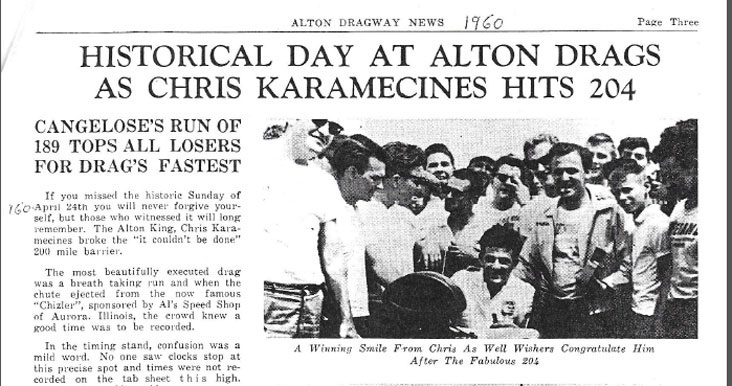
Glad you (I) asked. Bob Frey sent me a copy of a page from the Alton track’s newspaper that shares their side of it. Aside from the unfortunate typo on his last name in the headline and throughout the story, there’s some good stuff here.
“In the timing stand, confusion was a mild word. No one saw clocks stop at this precise spot and times were not recorded on the tab sheet this high. Finally, the public address announcer, the congenial Bruce Flanders, uttered the fantastic time to the crowd, that to the best of his knowledge, the clocks showed 204 miles per hour. Mr. Garland Tyler, the strip manager, was at the timing stand in a hurry and without hesitation OK'd the time. Mr. Larry Bouldin, the official photographer of the American Hot Rod Association, took several shots of the Fosdick timing clocks in the fabulous position”
Notice the peculiar wording there? "To the best of his knowledge ..."
Then, in what has to be one of the weirder sentences in any drag racing publication but perhaps included to allay any fears that the 204 was wind-aided in any way:
“Looking across the Alton Dragway, the smoke was rising almost straight up at the boiler house of the Alton State Hospital, showing the wind velocity to be practically nil.”
Didn’t “the Greek” back up that 200 many more times before Garlits’ 200 in 1964?
Later in the summer of 1963, he got a questionable 213-mph time slip at Kansas City Int’l Raceway and Rod Stuckey supposedly drove “the Greek’s” car to a 214.28-mph pass in Phoenix in February 1963.
What makes Garlits’ 200 any more official?
“I ran some 200s [including 200.44 in Detroit the weekend previous] before I ran the 200 at Island, which had Chrondek timers and the NHRA had a point meet going on so that means the record books were open,” Garlits explained. “So that was a different deal. Chrondeks had something in them where it didn’t make any difference about the voltages so that the clock always got the same voltage.”
And what does Kalitta say?
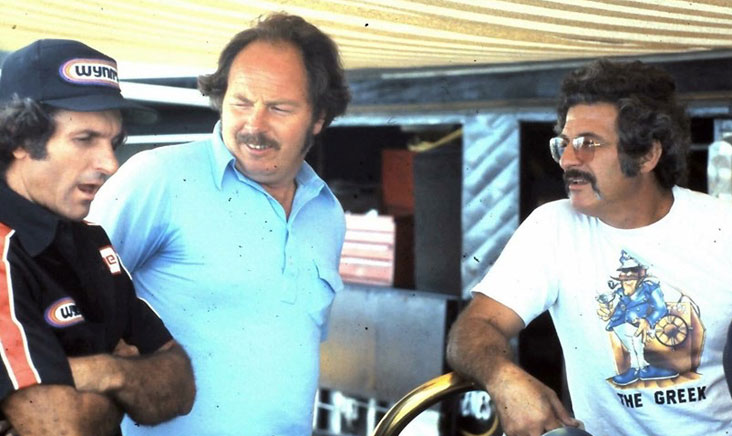
During an interview with Mike Dunn during an ESPN-aired NHRA event, Kalitta claims that he made the first 200-mph pass at the Nationals in Indy in 1964 and that “the Greek’s” run didn’t count because of the Fosdick timers and that Garlits’ Island pass shouldn’t count because Island Dragway used hoses (like the old gas-station alert hoses) to trigger the finish line clocks while Indy had real photocells.
Garlits’ retort was classic: “Is that what he said? He’s terribly mistaken. I’ll have to refresh his memory.”
Did “the Greek” run hydrazine on the 200-mph pass?
Although Maynard was known to tinker with the exotic and explosive add-on, Karamesines’ recollection is that he was not running hydrazine at Alton.
Didn’t that car end up in a museum? Which museum?

More like museums. After the 1962 season, the car was installed at the Chicago Museum of Science and Industry, where it stayed for 22 years, then spent another eight in Garlits Museum of Drag Racing before Karamesines got it back.
I heard “the Greek” also had a twin-engined car.
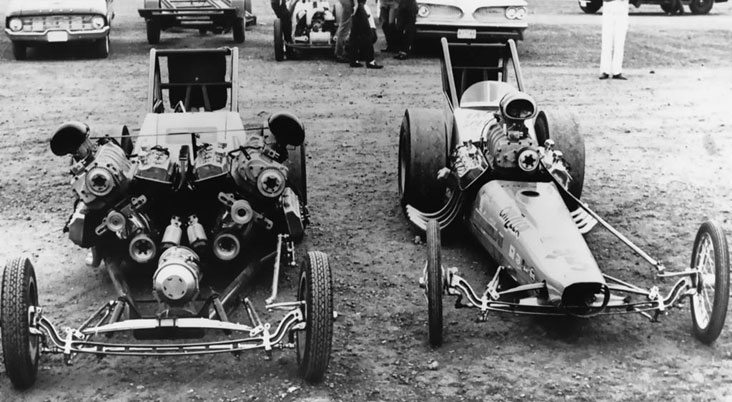
He did, for a very short time in 1962. It was a side-by-side twin that ran in match races only. It was dubbed Chizler 2 and driven mostly by Maynard. According to DragList.com, the twin’s best speed in 1962 was 183.00 at Oswego Dragway, so they had two pretty good running cars.
How would Maynard have compared to crew chiefs in the modern era?
“He would have fallen right in there,” said Karamesines. “He was that smart. It would have been a really good thing if he’d lived longer.”
What happened to Maynard?
After Stuckey built a new 126-inch car for the team for the 1963 season, they planned to head west to debut the car at the AHRA Winter Nationals in Phoenix in mid-February. “The Greek” apparently was already there when Maynard and co-driver Kenny Hirata (of Hirata & Hobbs fame) left Chicago with the team’s spare 392 engine. Maynard was killed in a head-on collision with a car that crossed a median after its driver reportedly fell asleep. Hirata also was injured but survived.
What happened next?
Devastated at the loss of his dear friend and partner, Karamesines headed back to Chicago to be with Maynard's family. Stuckey drove the car in his place to test some new M&H tires they had recently acquired and ended up setting low e.t. of the meet at 7.81 and the questionable 214-mph speed but used up two engines in the process and was unable to back up the 214. “The Greek” returned to drive the car at the March Meet.
What’s the story behind “the Greek” then running the first seven in March Meet history?
While a number of drivers had received seven-second clockings at meets across the country, by all accounts, Karamesines 7.99 at Bakersfield also was the first seven at a major meet.
According to longtime Drag News reporter Ralph Gudahl in a 1977 National Dragster interview, after Karamesines suffered an early-round loss, “Ted Frye, who was the Isky field rep at the time and a real close associate of ‘the Greek,’ went up to Chris and reminded him that every year that he had come to Bakersfield he had always given the fans something to remember. This perked Chris up quite a bit and he worked feverishly on the car to set it up for a seven-second run, which no one had done at Bakersfield at the time.
“Well, he came up to the line and let loose on a ‘banzai pass,’ losing the blower belt right before the finish line, but still clocking an 8.03. Chris went back to the pits and worked on the car even harder. He came up for another single, and this time he went 7.99 and the stands just came unglued. To me, it was one of drag racing’s most beautiful moments.”
How did “the Greek” do after Maynard’s passing?
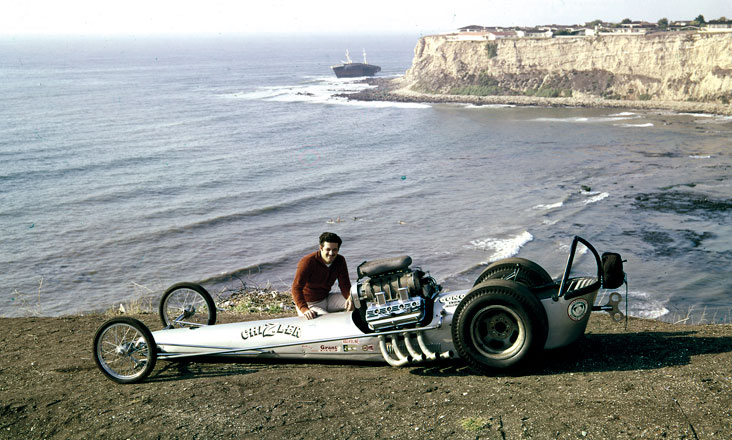
Because the basic combination was there, even without Maynard’s renowned ability to read the track, Karamesines went on to win a lot of match races and set track records everywhere. Stuckey added a full body to the front of the car sometime later that year and “the Greek” finally earned the #1 spot on the Drag News Mr. Eliminator chart, taking it from Art Malone in July and held onto it for five months before being dethroned by Norm Weekly in a controversial match at Pomona on Dec. 8.
Controversial how?
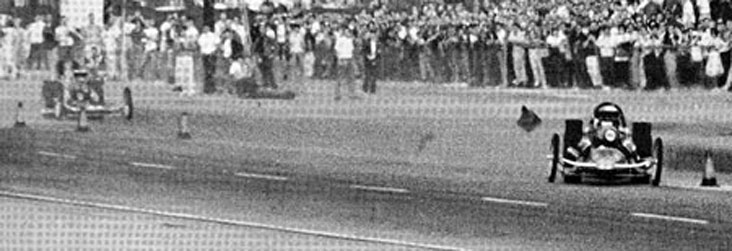
Weekly, at the wheel of the crowd-favorite Weekly-Rivero-Fox-Holding "Frantic Four" dragster, won the first of the best-of-three on an 8.06 to 8.04 holeshot. "The Greek" won round two with an 8.06 after Weekly red-lighted. In the all-important rubber match, one report says that Weekly fouled and another says that Weekly got super crossed up after a wheels-up launch and maybe crossed the centerline. Karamesines, meanwhile, drove through a monster midtrack wheelstand of his own and made both points moot when he definitely crossed the centerline (see photo above), and Weekly coasted to the win with a 15.79 at just 51 mph. Officials ruled that Weekly had not crossed the centerline, but many in the crowd wanted a rerun for proper finale (they didn’t get it).
According to Lions track reporter Gudahl, Karamesines also was the first non-West Coaster to win a match race at Lions Dragstrip, defeating Don Prudhomme with a wild, crossed-up wheelstanding run in 1964. According to at least one story, the run earned him the “Crazy Greek” nickname.
Runs like this one, right?
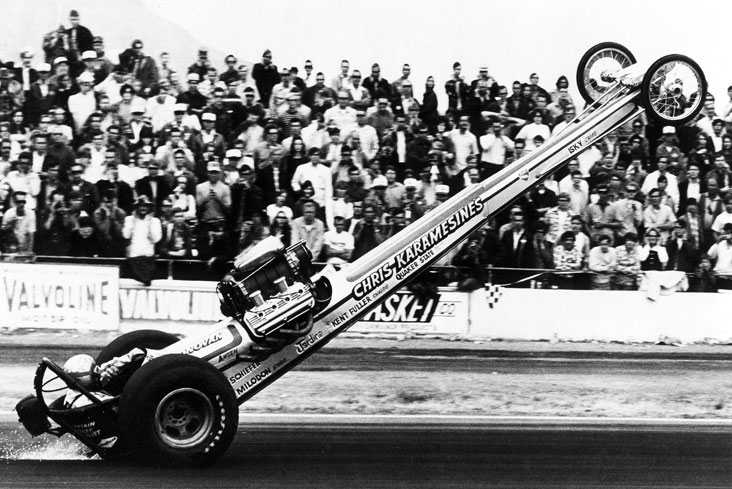
As much as a lot of people like to think this is the archetypal photo to describe “the Greek’s” mad driving skills, I’m told that this is actually hired gun Cliff Zink behind the wheel during this 1970 moonshot in Karamesines’ car. Sorry.
Surely you do have some photos of "the Greek" doing wheelstands ...
Just a few ...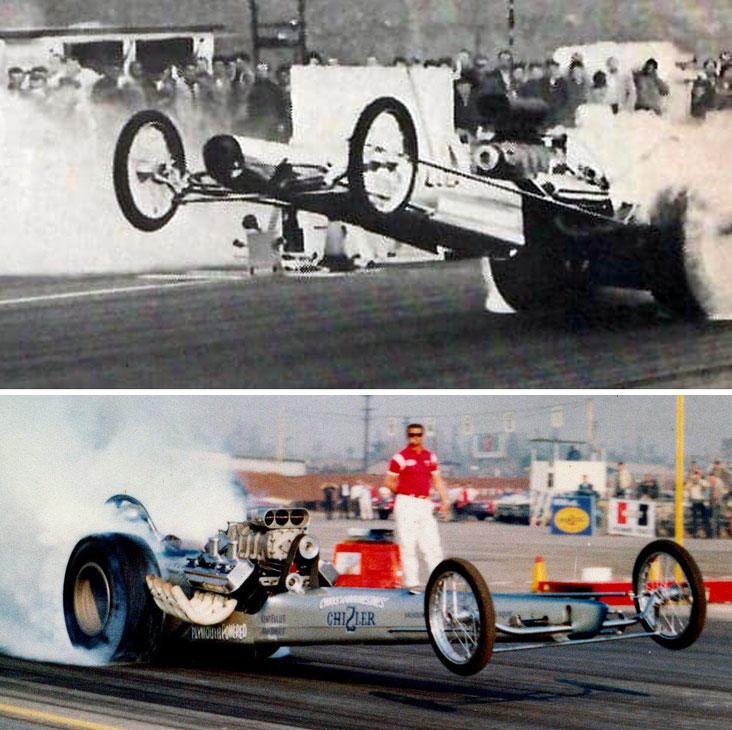
Regardless, what do you think made Karamesines such a fearless driver in the 1960s?
Before guardrails were introduced, Karamesines sometimes went off the track, only to resume the run under full power and occasionally win the race or drive through crazy mid-track wheelies. He had that never-lift spirit and it served him well. He didn’t get the nicknames “the Crazy Greek” and “the Mad Greek” by accident, but there was a method to his madness.
"Driving those [dirt cars] would help you really develop a seat-of-the-pants feel," he explained. "You'd slide into the corners, spinning the tires, and develop an entirely different set of reflexes. It was never my intention to drive a dragster recklessly or just try to thrill people. I think the dirt-racing experiences helped me. We ran a lot at Lions, and we knew that its close location to the ocean would develop dew on the surface when we raced late at night. That would make the tires spin more and caused the car to get sideways. I was able to save a lot of runs because I had more experience with that.
“Of course, once you really got used to a car, you could do a lot of things with it. You just want to win, so you do anything to get from one end to another, even if that meant running off the track and back on or driving through wheelstands and recapturing them without destroying the car.”
That kind of experience helped on dragstrips of all quality, from national event-level tracks to what historian Bret Kepner used to call “big four” tracks: “Short, dark, narrow, and slippery.”
What was a typical year on the road like for “the Greek?”
“We used to go to 50-100 races a year, sometimes racing twice a week,” said. “There was no shortage of tracks that would run fuel cars; there must have been 100 of them from coast to coast. Each one of them was a different thing from New York to Boston to Canada to California from one end to the other. We’ve hit every state except Alaska, I think.”
How did teams afford that?
According to “the Greek” in a 1992 interview with ND, “Back in 1965, three days on the road and at the races might only cost you $200. You’d pay $6 or $7 a night for a hotel, 28 cents a gallon for gas, and 35 cents for a hamburger, If you won a race, you could make $500-700, and in California that number could go as high as $1,500."
What’s the deal with that Cadillac push car he used to have?
According to “the Greek” is a 1960s interview in National Dragster, “This car is insurance. You make a date at a strip, you've got to get there. And you might as well go in comfort and get there well-rested."
The story is that the Caddy had a killer sound system (well, for the day), including a headphone jack so that the co-pilot could sleep while the driver kept the tunes playing to stay awake.
What was “the Greek’s” first NHRA race?
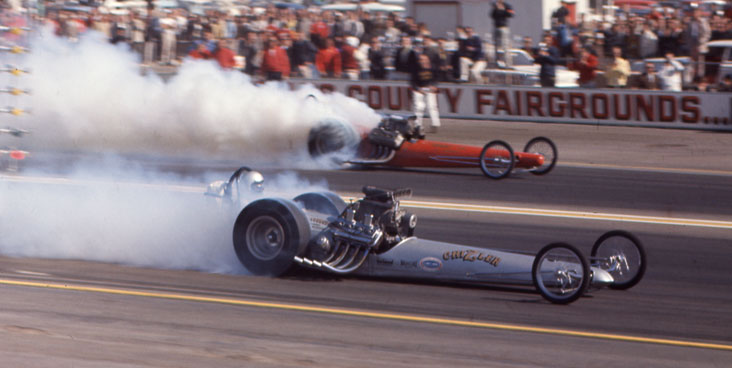
The 1964 Winternationals. He beat Denny Milani in round one but red-lighted to Tommy Ivo in the second round.
Did he really beat Garlits in 23 straight match races in 1966?
Absolutely. Garlits readily admits it and also to the fact that when he put “the Greek’s” car into a display in his museum, that he put his own Swamp Rat VIII side by side with it but a few inches ahead “just so I can say I won one race against him.”
Swamp Rat VIII was Garlits’ first car with the 426 Hemi instead of his tried and true 392, and he struggled mightily with it.
For all of his match-race success, “the Greek” didn’t win many national events, did he?
True, but a) There weren’t 24 national events a year back then and b) He put much more emphasis on the match races. He was quoted in 1967 as saying, “My chief goal in life is to give the spectators a good show.”
He did win the 1966 AHRA Nationals at Green Valley Race City in Smithfield, Texas; the ’68 AHRA Springnationals in Bristol, Tenn.; the 1972 AHRA Marathon Nationals in Larue, Ohio; the 1978 IHRA Empire Nationals in Rochester, N.Y.; and the ADRA World Finals in Spokane, Wash., in 1984 and 1985.
No NHRA wins?
Nope. He reached two NHRA national event finals, both in 1990, but lost both times to Gary Ormsby. I’ll touch on that more later.
I read he was in three NHRA finals. What’s up with that?
That’s from an erroneous factoid that was in the NHRA media guide and keeps getting repeated as people copy and paste from other’s facts. It states that “the Greek” was in the Top Fuel final at the 1965 Springnationals in Bristol, Tenn. Not true. Maynard Rupp won the final there against Connie Kalitta. According to Bob Frey’s immaculate career stats, “the Greek” was a first-round no-show at that race.
But a lot of success on the AHRA side?
Yep. When Jim Tice started the Grand American Series, he was savvy enough to lock down top draws like Garlits and “the Greek” and even if the events weren’t at tracks as posh or receive as much television or press exposure as NHA’s national events, they drew scores of crowds.
You promised us 90 or so questions. Phil. How are we doing so far?
Thanks to this self-serving question, we’re about halfway there but the rods are starting to knock and the cylinders are starting to drop. This was a bad idea.
Tell me about the fabled “Greek Fleet” that Karamesines organized.
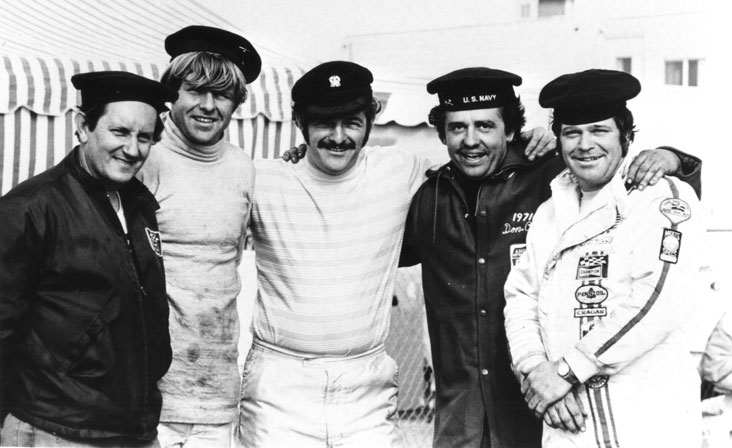
The “Greek Fleet” (of which, Karamesines had awarded himself the title of “Captain”) was comprised mostly of (as shown above, from left) Bob Creitz, John Wiebe, Don Cook, and Jim Nicoll, but also included a few others from time to time, but this quintet was the core. Many comparisons have been drawn between the “Greek Fleet” and Frank Sinatra’s notorious “Rat Pack.”
I called up my old pal Wiebe to ask about the fleet’s origins and its inner workings.
“We were all on the AHRA circuit and hung out and traveled together,” he recalled. “You get five guys together and it doesn’t take much beer to come up with stuff like that. Of course, Chris had a huge love for boats, so it all made a lot of sense and the announcers loved it.
“When we traveled together, I always brought up the rear because I was the only guy who had a kit to fix tubeless tires without taking them off, so if they had a flat tire they’d pull over and I’d help them.”
While Karamesines was the unquestioned leader and captain (and sometimes referred to as “the admiral"), his shipmates’ ranks changed regularly, from First Mate to Cabin Boy and everything in between.
“Depending on how you ran was what your title was,” explained Wiebe. “I ran OK so I usually was a Gunner’s Mate, not prestigious but not Cabin Boy. If you were Cabin Boy, you were in trouble, you were on parole. Nicoll and Cook were always in trouble with him for doing things like breaking into the laundry room at the hotel, stealing all of the towels, and handing them out in the pits."
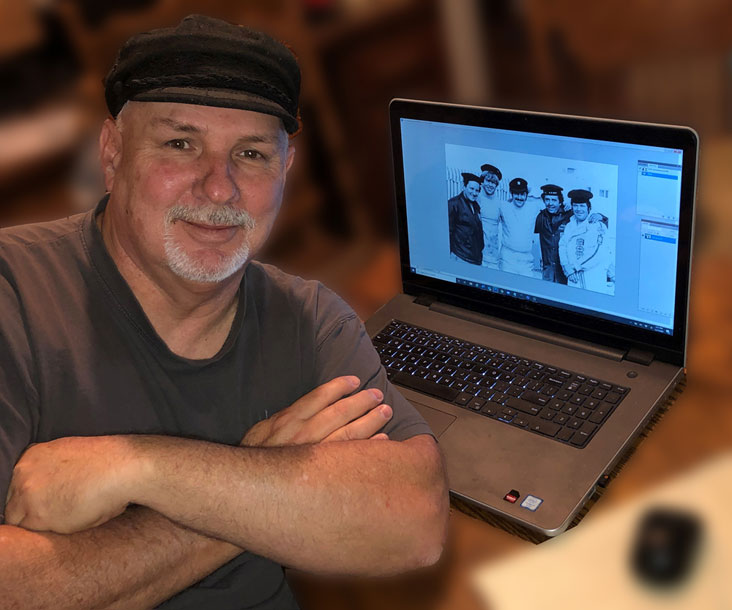
After our interview, Wiebe generously offered to give me his “Greek Fleet” hat, which I graciously accepted. I think I look pretty damn good in it. The word "jaunty" springs to mind. My family begs to differ.
Speaking of funny-looking things, did “the Greek” actually run a Funny Car?
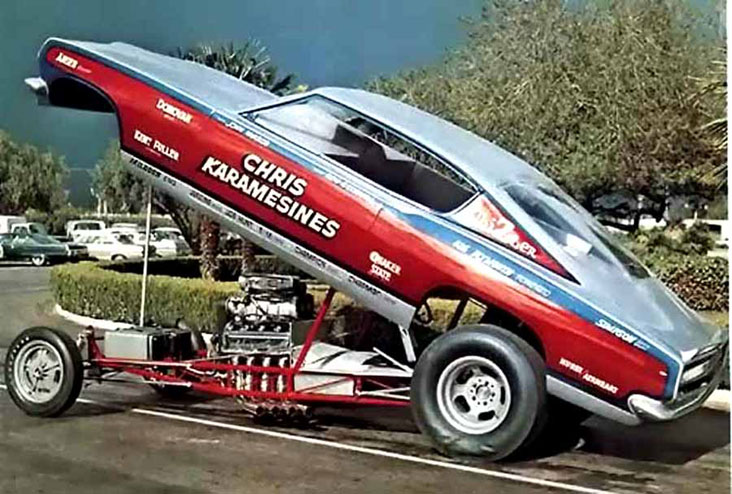
He did. As Funny Cars began to sap match-race dates away from the Top Fuelers in the late 1960s, Karamesines in 1969 commissioned the construction of a Barracuda flopper from Kent Fuller and hired guys like Pat Foster, Norm Weekly, Ron O’Donnell, and Cliff Zink to drive that car and fulfill match race dates.

“The "Greek" didn’t drive a Funny Car — and then only sparingly — until 1971 with this Romeo Palamedes-built Mustang, which also housed his first 426 Hemi. He did compete in this car at the 1971 Gatornationals (qualified No. 15 but was a first-round no-show). The 323 on the flanks here is the giveaway that it was actually “the Greek” behind the wheel.
He also was one of the few Top Fuel drivers with a wedge dragster, right?

Yep. “The Greek” joined the parade of others — including Don Prudhomme, Connie Kalitta, Kenney Goodell, and Leland Kolb — who experimented with a tilt-up aerodynamic rear section and quickly abandoned it due to weight and the difficulties involved with servicing the car. The chassis was built by Don Garlits and was the second rear-engine car he sold to another racer (Tom McEwen was the first customer). You can read reams of wedge-dragster material that I researched and wrote about in the spring of 2010. Check out the Insider archive.
Tell us about the gold-plated car

Man, I wrote a whole column about that car back in 2012. In a nutshell, as I wrote, the car was "covered from wingtip to front axles in 24-karat gold. And I do mean covered. We're talking rear wheels, wing struts, spill plates, injectors, valve covers, roll cage, steering wheel, hand brake, and windscreen all the way down to the nuts and bolts, and even the Dzus fasteners had been plated in pure gold. Even his helmet was gold-plated.”

He debuted and destroyed the car at the 1975 Gatornationals after a rear wing failure sent the car plunging into the left-lane guardrail. Although the parts weren’t hewn from gold (naturally), they were gold-plated and estimates of the amount ranged from 22 to 44 ounces, the crash nonetheless launched an after-hours scavenger hunt for pieces.
Is that where he got the nickname “the Golden Greek?
In an interview I did with him for that story, Karamesines says he already had that nickname. “You’re always trying to do something nice with your cars, and I thought that would be a nice thing. People were already calling me ‘the Golden Greek,’ so I decided I’d put as much gold on it as I could.”
How much national event racing did “the Greek" do in the 1970s and ‘80s?
I only have access to his NHRA records. He competed in just 15 of the 83 NHRA events in the 1970s (match racing was still big then) and won just two rounds. With the match race scene drying up, he competed in 39 of the 132 NHRA events in the 1980s but won just three rounds and DNQ’d 14 times, so clearly not his best decade.
Strange was a big “Greek” backer in the 1980s. How long were they with him?

After sitting out the 1981 and ’82 NHRA seasons, “the Greek” returned to the national event battlefield in 1983 when longtime friend Bob Stange of Strange Engineering began backing Karamesines. He typically would run five to seven events a year throughout the decade, but always Gainesville and Indy, and usually Columbus and Englishtown plus some trips out west for the Winternationals. That was his pattern for the 1980s.
The relationship between Karamesines and the Stange family began as a friendship in the early 1960s and when “the Greek” started breaking axles (which, at the time, were rebuilt factory axles) in the powerful Chizler, Stange was there to help with better, stronger axles.
The relationship personal and professional, continues to this day, even as Stange’s son, Jeff, has taken over the company.
“It was never about business or money or marketing between my dad and ‘the Greek’; it was always about their friendship,” said the second-generation axle ace. “It’s still that way today. Chris is like a second father to me. I can’t express enough what they’ve meant to us all these years.
“I will always recall leaving a Joliet race at after midnight and thinking I’d accomplished a lot for the day, only to walk by ‘Greek’s ‘trailer with him looking at and reviewing data with a single bulb lit in his trailer. I remember smiling and thinking, ‘I need to work harder.’ That’s ‘the Greek.’ For him, it’s all about the process, taking what you have and making it work, and working very hard for that.”
Then came the magical 1990 season. Tell us about that.

After running a decade-high eight events in 1989, “the Greek” ran all 19 events in 1990 and finished just 36 points out of the top 10. He was 61.
In 1989, he had hired Lance Larsen, who had tuned Jeb Allen to the Top Fuel championship in 1983, and Larsen recruited two more nitro geniuses in Dave Settles and J.T. Stewart for the 1990 season.
They qualified at 16 of 19 events and had early highlights like beating Kenny Bernstein in round one in Gainesville and again in Columbus, then headed north of the border for the annual Le Grandnational at Sanair Dragstrip outside of Montreal.
“The Greek” defeated Canadian Hector Pickering in round one, 5.26 to 5.53, then beat Winternationals champ Lori Johns, 5.11 to 5.21, and, in the semifinals, points leader Joe Amato, to earn a final-round date with reigning world champ Gary Ormsby and the Castrol GTX dragster.
How much did everyone want to see “the Greek” win?
I was there and, no offense to the great G.O., I don’t think he had many rooters. Even Ormsby admitted on camera before the final that he wouldn’t even take his car to the starting line if he wasn’t in the thick of the points battle with Amato.
Ormsby put those emotions aside and drilled “the Greek” on the Tree (.444 to .532) and outran him, 5.20 to 5.38. The win gave Ormsby the points lead and moved Karamesines into the top 10, possibly for the first time in his life. Check out the video below:
The scene was repeated a few weeks later in Seattle when “the Greek” and team, coming off a tough DNQ in Denver, reached the final round by going through another murderer’s row — Shirley Muldowney, Frank Hawley, and Frank Bradley — before losing to Ormsby again, 5.09 to 5.51, and “the Greek” ascended to a season-high ninth place in the standings.
What are Larsen’s memories of that time?
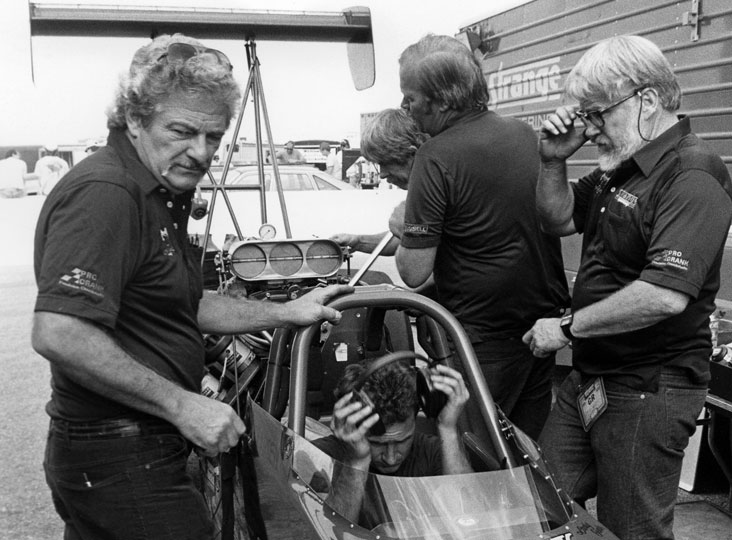
“I was recommended to ‘the Greek’ by a friend and already had a history of living in Chicago, so I was looking forward to going back there,” he remembers. “He could still handle the car. He was never a phenomenal leaver, but during the blowover period if he did a wheelstand he would drive it so well; he had a really good feel. He was always a hard worker. I was 43 he was 61, and I couldn’t keep up with him
“He’s an absolutely wonderful man and would do anything for the people he cares for, and he cares for a lot of people. He’s a special human being. When I went to work for him it was at the end of my time of being a recreational drunk and a drug addict, and I know that he was really proud that I had straightened myself out. We rode together in the crew cab and talked a lot. It will always be a special time for me.”
After an all-out 1990 campaign, Karamesines ran just two events per year (Gainesville and Indy) from 1991-93 and DNQ’d at all six (though he did get into the '93 Indy field as an alternate but lost in round one). He didn't drive again in national event competition in 1999 when NHRA came to Chicago and "the Greek," of course, couldn't pass up that opportunity.
What did he do between 1994 and ’99?
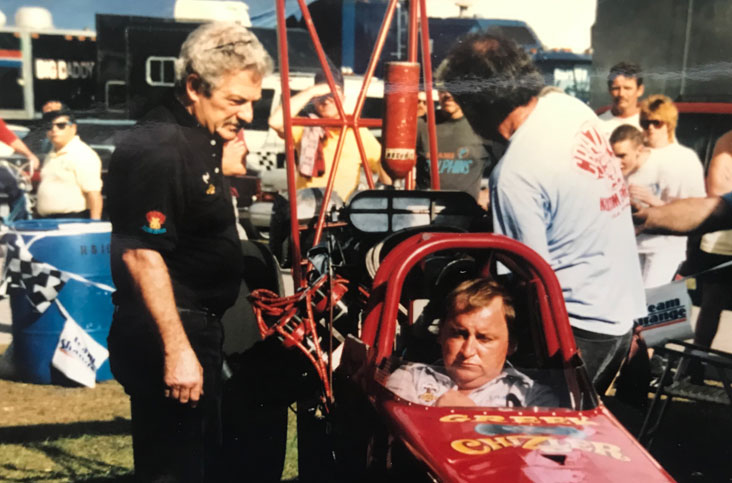
Enter Bobby Baldwin. The SoCal Top Fuel favorite, as likely to be seen driving his dust-settling water truck around the Pomona track as much as his dragster on it, had fallen for “the Greek’s” daughter, Paula, which led to nuptials, and when “the Greek” decided he might be ready to step aside, Baldwin became the natural choice.
I bet you’ve got a cool story about Bobby and Paula …
I do.
The first meeting of the couple came at the 1990 fall Dallas event. “The Greek” and Baldwin ended up pitted net to one another at Texas Motorplex.
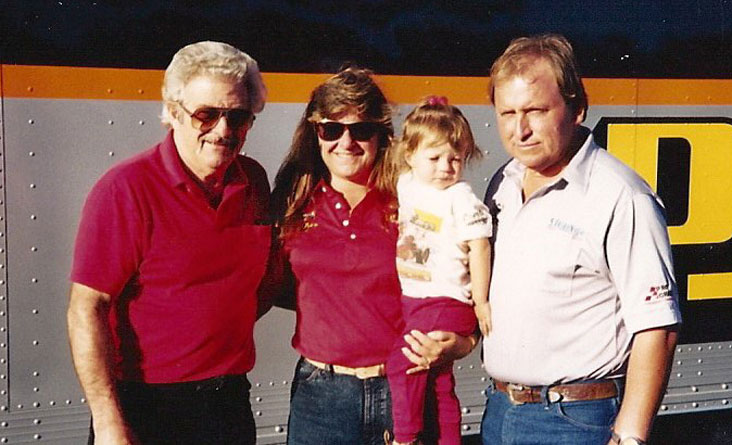
According to Krista, “My mom had a popcorn business and didn’t have a microwave in Grandpa’s trailer and asked Lance [Larsen] if he knew someone who did. Lance had helped put my dad’s car together a few years earlier and told her to go over to my dad’s trailer, and that’s how they met. They had their first date at the John F. Kennedy memorial site in Dallas. My dad was obsessed with JFK but had never been there, so my mom suggested it. They got married a couple of years later.”
What happened to Baldwin?
Tragically, he died in September of 2001 of a brain aneurysm. He was just 47.
For a guy racing out of his own pocket, he impressed us all. According to Frey, he was able to compete at 75 NHRA events and recorded a runner-up in Houston in 2000 behind Cory McClenathan.
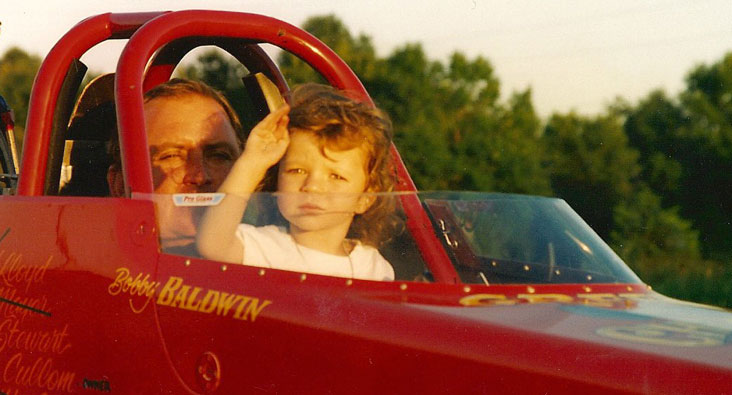
After licensing with an early shutoff 3.99 in October, daughter Krista, who was just 8 when he passed, will now continue the family legacy in her grandpa's car and will wear her dad's number, 725, on her car when she debuts at the 2021 Gatornationals.
The Gatornationals has quite a bit of significance for the family. “The Greek” hasn’t missed a Gatornationals in decades (if ever) and the Gatornationals was where Bibby Baldwin first qualified for an event. After a DNQ with the new car at his hometrack Winternationals in 1988, Baldwin qualified in Gainesville and beat SoCal neighbor Robert Reehl in round one and three-time world champ Shirley Muldowney in the second round.
This has to be very emotional for everyone involved.
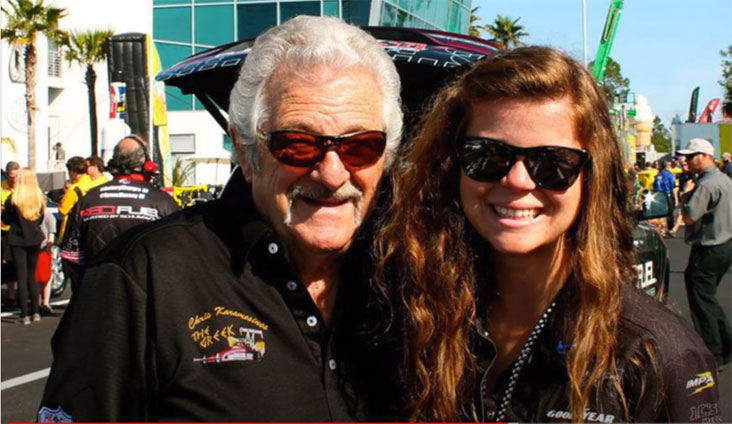
Recalls Krista, “After I made that [3.99] run, my grandpa got out [of the tow vehicle] at the top end and he was crying, and I was crying, and he said, ‘You did good, kid.’
“It was the epitome of living the dream for my dad. To be staging the car and to know what he was doing, how it felt, and what was going through his head whenever he got into the racecar, it almost transforms you.
“We all know that he was there for it, that he saw it. It was very surreal, and I felt very completed. I feel like it was meant to be, that I was meant to be a Top Fuel driver, not only for myself but also for my dad.”
When did “the Greek” come back to NHRA competition?
At the 1999 event at Route 66 Raceway outside of Chicago. The event had debuted the year previous and although he didn’t make the field in 1999, it just felt so right to have him at a national event outside the city that best represents him.
Since then, Karamesines has sat out two more seasons (2006 and 2008) and run schedules varying from one race (2007) to 17 (2002) but has run from 8-13 races a year over the last decade.
When did Lucas step in to help him?

Lucas Oil backed "the Greek," for seven national events in 2011 and, in March of 2012, company owner/founder Forrest Lucas offered “the Greek” a lifetime sponsorship to keep him out and running in front of his fans.
"The Greek is a legend in our sport," Lucas said. "He's a great ambassador for drag racing and our line of products, and we're happy to partner with him again. I look forward to seeing 'the Greek's' dragster go down the track with our colors on his car for many years to come."
In 2015, Don Schumacher Racing provided him with one of its previously run canopied dragsters to keep the legend rolling.
His friends obviously think very highly of him.
Imagine being John Wiebe, who said that as a kid he watched “the Greek” race in Oswego, and then not only got to race against him but be part of his entourage.
“Years later I started racing, running for [Jim] Tice on the AHRA circuit, and raced against him for the first in Kansas City,” he recalled. “Here I was, this snotty-nosed kid watching him race and a few years later you’re racing the guy.
“He’s the classiest guy I ever met in racing. Very classy; I never saw him dirty or greasy.”
We understand that “the Greek” is as popular as the Cubs in Chicago?
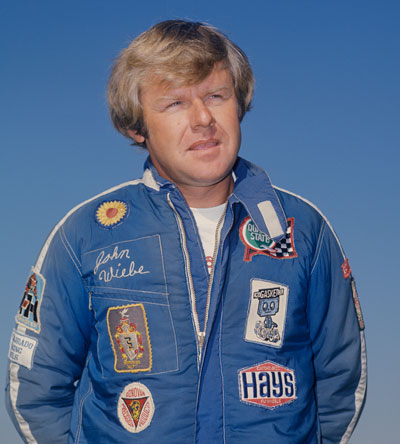
Boy, almost. Wiebe (pictured right) told me a story about “the Greek” taking him and some others on a ride on his 52-foot Chris-Craft boat down the Chicago River that runs through the heart of town and people were calling out “Hey Chris!” from the shoreline and bridges.
Larsen also shared this story:
"He took me downtown to Greektown one year for my birthday and bought me dinner. The maître de kissed him and took him to his table. The waiter kisses him and says hello. The guy who owns the place kisses him and visits. Then the chef comes out and takes his order. That's the kind of reception he'd get all over downtown Chicago."
Karamesines lived on Chicago’s south side — “the baddest part of town” as made globally notorious by singer Jim Croce in “Bad, Bad, Leroy Brown” — but no one messed with him or his shop.
“That is one famous dude,” Head agreed. “His shop is in a rough part of town, but he knows everybody, and he's got all the cops taking care of him. He had a lotta friends on the force. He’s just the friendliest guy in the world. He doesn’t have enemies but has a lot of friends, especially in Chicago.”
What do those closest to him say about being in the orbit of the man, myth, and legend?
Wife Sandy just sighed when I asked her what it was like trying to keep up with him.
“He keeps me running, that’s for sure,” she said with a laugh. “It’s not easy keeping up with him. Physically and mentally, he’s just not the age he is. He’s never going to be the guy sitting on the couch. He just keeps going. He loves racing and it’s the friendships that really keep him going.”
She should write a book about her time with “the Greek.”
"I started a book several years ago because people kept saying we should," she said, "but every article I see about him goes through his history year by year and seems to be the same [until she sees this one!] and I wanted the book to be just interviews with people like Garlits and Prudhomme and Kalitta who could each share funny stories about him. I think that would be very interesting.
Phil, I bet you can help her out …
Wiebe told me this great one:
“I’d winter in Los Angeles and Sid Waterman had a Christmas party or a New Year’s party at his shop on Gardena Blvd. ‘The Greek’ showed up fashionably late and had an armful of roses that he gave a rose and a $20 bill to every girl and woman, married or single, at the party, and then he leaves. Who else would do that?”
Didn’t Prudhomme say some cool things about him in his new book?
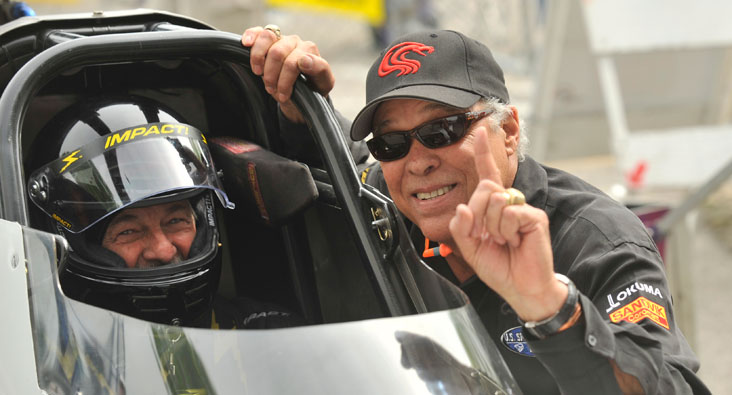
Absolutely. The “king of cool” called “the Greek” cool, too. Relating his first meeting with him during his 1960 tour of the U.S. as a hired hand for Tommy Ivo, “the Snake” recalled, "I had not met him before, but I’d seen him in the magazines, and he was just so cool. He had this bitchin’ mustache, and the car looked great. I can still picture him doing a burnout, the smoke billowing out in front of the engine and you could see his hands in there driving the thing. I thought that was the ultimate. When I got to meet him, he didn’t disappoint.”
Prudhomme talked about "the Greek" taking him under his mechanical wing and then inviting him and his wife Lynn and inviting them to dinner at his house ("Oh my God. I get to go to Chris Karamesines' house. Wow! Wow!").
“I wanted to be like ‘the Greek,’ not Ivo … he was cool, like Elvis. Staying with him, that was like staying at Graceland or something. The biggest [expletive] thing in the world.”
(To be honest, I felt the same way when “the Snake” invited me to his house for a Christmas party one year; read about it here)
What’s your personal favorite “Greek” story, Phil?
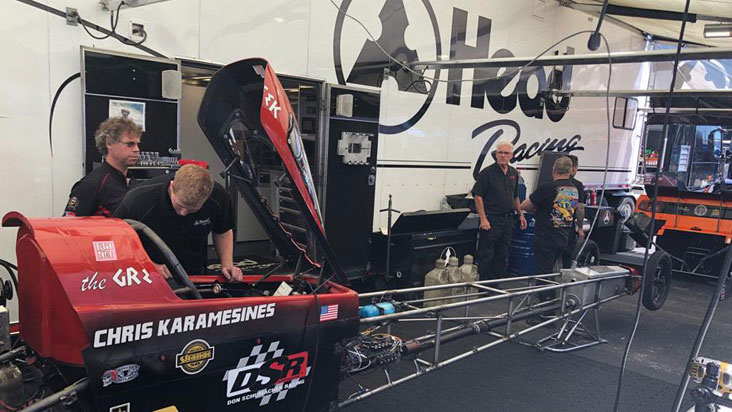
At the Norwalk race in 2019, I saw “the Greek’s” car in Jim Head’s pit area, so I stopped in to see what was up with that. Was Head switching back to Top Fuel? Nope, turns out he was putting one of his Funny Car engines into “the Greek’s” dragster.
"We pit next to each other every race he runs, and I've watched him struggle race after race with his own stuff, and I and a lot of other people have been over into his pits trying to help out, but I finally decided it's easier for me to put one of my engines in his car than do that," Head told me.
It was at this point that "the Greek" walked into the trailer, and — honest to God — in a stereotypical grandfatherly way, he handed us each a Werther's Original hard candy and waved off any chance of a real interview.
"He's just trying to make a point that he can make the car run and I can't," he said good-naturedly of Head, and walked off.
Head and “the Greek” are close? They seem like opposite sides of A coin.
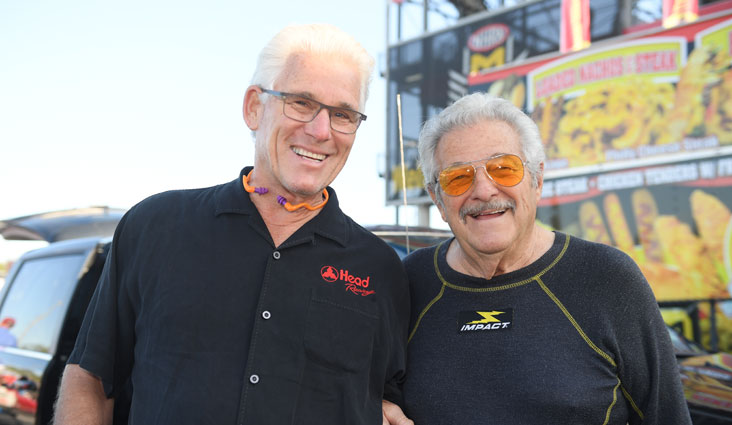
Super close. And Sandy Karamesines says that Head is the only one who can yell at "the Greek" and get away with it.
"He just loves drag racing and I'm just the exact same way; we just love to race our [stuff], and that's why I think we get along so well," Head explained. “We’re both in it for the same reason.
“I first met him in the winter of 1979 in Bradenton, Fla., when I had my alcohol car. We hit it off and were friends one and off for a long time, but for the last 20 years we've been really close. We talk about everything, airplanes, and boats. He's been down the islands here [Turks and Caicos, where Head has a winter home] with me and we went to Greece together a few years ago, and we went Hawaii together and hung out with Myles Togioka, who has an A/Fuel Dragster.
“He is such a personable guy,” said Head. “He's probably you know one of the most magnetic people I think I've ever been around. He is as unique as any human I’ve ever known. You just run out of superlatives.”
Tell us more, Jim.
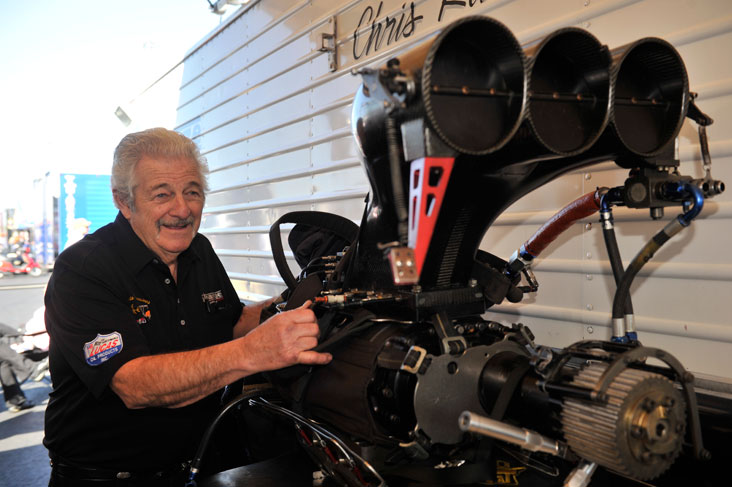
“He’s the hardest working human I think I ever met,” he said. “I like to work, but he’s crazy. He just keeps on keeping on. He just works on this stuff. He still builds his [piston and rod] racks, he still gaps his rings, he still checks his pistons and rods every run
“He just keeps on keeping on. He doesn’t have quit in him, but it's racing that keeps him alive I'm positive of it. He just loves the sport. It’s got nothing to do with money or fame. He just wants to get down the racetrack; he's not happy with it runs slow and not happy when it blows up, but I honestly feel that the majority of racers just put their head down and go do it again."
Head’s not the only one to have helped him recently, right?
Not by a longshot. So many tuners over the years have had a soft spot for him. Just recently, Don Schumacher and his talented tuner, Todd Okuhara, got him into that canopy dragster with a good combination, and Bobby and Dom Lagana have both offered their expertise. People have offered everything from tune-up advice to turnkey combinations, trying to get Karamesines his first NHRA win before time expired.
You’d think with 60 years of nitro racing, he wouldn’t need any help.
Explains Head, "Back in the 1950s and '60s, all you had to worry about the pill [jet] size; you put 10 pounds of compression in the thing and then you change the pill from an 80 to a 90 and you maybe run the blower up a couple [of percent] and maybe one [degree] in the mag and that was it. Today, these cars are complicated to the max and he can't keep up with the cars today and, quite frankly, many old-timers can't.
“You also have to have a significant payroll and some full-time guys. You can’t do it right with volunteers like we used to. We used to all be volunteers. You might get a pit pass back in the ‘70s and ‘80s or if someone would get you a room and a ticket and a hot dog, you are all over working a fuel car. Today, you just can't get the kind of help to keep the thing together.”
What ARE “the Greek’s” best performances?
3.897 at the 2009 Auto Club NHRA Finals and 313.51 at the 2015 Gatornationals. He made his first 300 mph run in 2001.
What’s the craziest thing you read about him during your research?
In a 1964 Sports Illustrated story “Fame and Terror at 200 mph,” a feature on Garlits not long after his 200-mph Island run, writer Mark Kraw described Karamesines as “a mustached, sleepy-eyed man who looks like a character out of Steinbeck's Tortilla Flat.” [John Steinbeck’s first commercial success, Tortilla Flat was a 1935 novel that portrays a group of friends enjoying life and wine no Northern California in the days after the end of World War I.]
Like a character from a Steinbeck book, his longevity is truly AND otherworldly amazing.
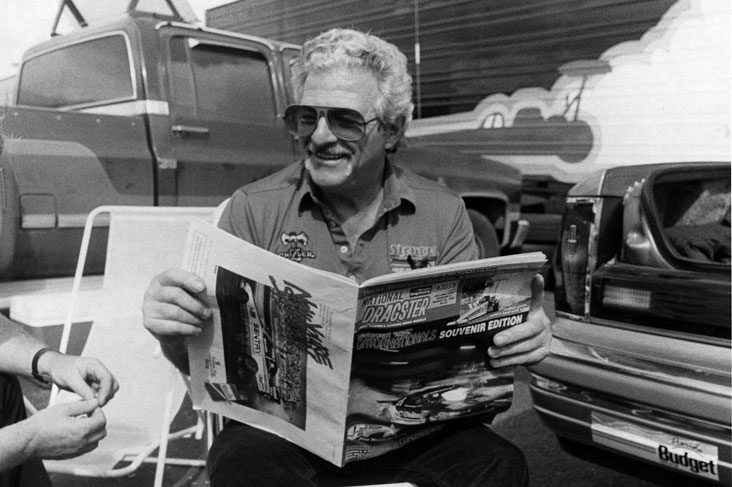
As Wiebe pointed out, “Someone who came to a race now that hadn’t come in a few decades and hears the announcer say Chris Karamesines’ name, he’s gotta be thinking that it’s ‘The Greek’s’ son, right? He’s been good for the sport. Some people don’t have to win to be good for the sport.”
“I don’t think what he has done will ever, ever be repeated,” opined Larsen. “Racing that long and doing it as well and he and being as well-thought-of as he is. No one will ever do what he’s done.”
Speaking of that, who takes over “the Greek’s” title as the oldest competitor? John Force?
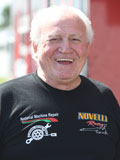
For the record, Karamesines was still “only” 88 (or 91 … lol) when he made what appears to be his final pass in a 300-plus-mph Top Fueler in round one of the Dodge NHRA Finals in Las Vegas, losing to Leah Pruett, who was born nearly 60 years after Karamesines.
“The Rodfather,” Luigi Novelli (right), who turned 78 last Sunday, is probably the new “old guy.” Karamesines’ fellow Illini Top Fuel pilot (Crete, Ill.) ran five races last year. Pat Dakin, who ran four events in 2020, will be 75 when the 2021 season starts. For the record, Force is “only” 71 (turns 72 on May 4).
What other kinds of honors Has KARAMESINES received in his career?
For starters, he’s a member of every Hall of Fame that really matters — the International Drag Racing Hall of Fame in Ocala, Fla., the International Motorsports Hall of Fame in Talladega, Ala., and the Motorsports Hall of Fame of America in Novi, Mich. — and some that aren’t even on the list. He was one of the few people on NHRA’s list of its Top 50 racers (No. 30) in 2001 who hadn’t won an NHRA event.
“The Greek” was only 30th on that list? Were you guys drinking at the time?
Believe me, there were a lot of people who thought he deserved a higher ranking but was hurt by the section of the voting criteria based on ontrack success at NHRA events, technological breakthroughs, and marketing/sponsorship breakthroughs. He, of course, scored high in contributions to the growth of NHRA drag racing and fan popularity, but there were people like Garlits, Force, Prudhomme, Muldowney, et al who checked all of those boxes.
So, how did “the Greek” finally know it was time to quit driving?
“After 70 years of going down the highway, I want to spend time doing different things with Sandy,” he said. “We’ve had a lot of fun for over 20 years traveling around the country and spending time with great friends, but I’m over it and look forward to doing other things.”
But have we really seen the last of his behind the wheel of a race car?
Garlits say no way, that promoters will be throwing money at him left and right to make appearances in one of his old cars.
And “the Greek” says?
“Possibly. A lot of people have said to me through the years that Sandy and I should take the 204 car and twin-engine car and go to some shows. We’re getting older now, so we might do that a few times a year.”
ONE MORE STORY, PHIL?
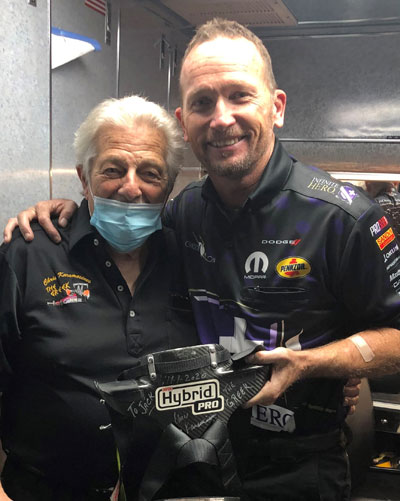
Sure thing, and a nice way to end this.
So, a dozen to so years ago, somewhere around 2006-07, when NHRA mandated the use of the HANS (Head and Neck Restraint System) Device, "the Greek" wanted nothing to do with them. He'd rather quit than wear one.
Funny Car star and student of the sport Jack Beckman would have none of it. He had a spare HANS and took it to "the Greek" and insisted that he use it, with the provision that when he did retire, he'd sign it and give it back to Beckman. Karamesines ended up driving so much longer that he had to get a newer HANS, and Beckman helped him there, too. "The Greek" credits Beckman for keeping him driving, but "Fast Jack" demurs,
"They're making me out to be a way bigger deal than I am," he said, almost embarrassed. "On a scale of 1-10 they're making me out to be a nine and I'm a 2. This is not me being humble. I'm not the reason he kept racing. He's Chris Karamesines. You could pass a hat through the pits and get enough money to buy him 10 HANS devices.
"But it's just a great example of a 'Greek' story. They get retold and retold and take on a life of its own. Even 'the Greek' changes his own story from telling to telling. Was he born in 1928? 1931? 1929? I think I've heard him say all of them. It's just part of the 'Greek' legend. But, as you can see, in Las Vegas after his last run I did get it back, autographed."
I SENSE YOU WRAPPING THIS UP NOW, PHIL. HOW DID WE DO ON THE 90 QUESTIONS?
Are we using Chrondeks or Fosdicks to keep track?
Phil Burgess can be reached at pburgess@nhra.com
Hundreds of more articles like this can be found in the DRAGSTER INSIDER COLUMN ARCHIVE



















































